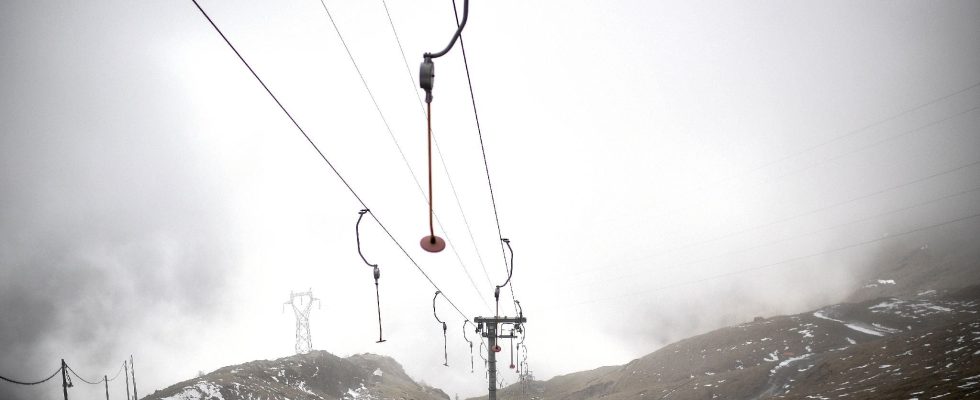Hurtling down a slope, feeling the sun stinging your face, and scratching your skis on gravel… It might take some getting used to. White gold, the treasure of winter resorts, is becoming increasingly rare, and its depletion seriously threatens the portfolio of the tricolor valleys. “The economic viability of a large number of stations is already seriously compromised in the short term,” warns the Court of Auditors in a report published on February 6. Rue Cambon is based in particular on a Météo-France document: projections for 2050 indicate a reduction in the duration of snow cover by several weeks. More precisely, the winter thickness of the snow cover would thus be reduced by 10 to 40% in medium mountains.
In total, some 80 of the 163 stations scrutinized by the Court’s experts present a high degree of “vulnerability”, particularly in the face of climate change. “Statistically, these are low and medium mountain resorts”, specify the wise people of rue Cambon. This is the case of Peyragudes, which appears in the ranking of the top five resorts in the Pyrenees. Nestled in the heart of the Louron Valley, straddling two departments, Haute-Garonne and Hautes-Pyrénées, the resort is one of the winter tourist sites most threatened by global warming.
Annualize the offer
Faced with this observation, a watchword: reinvent yourself. “We have to face the facts, with the acceleration of climate change, resorts can no longer rely solely on winter sports,” argues Laurence de Boerio, in charge of press relations for N’PY, a collective which brings together eight Pyrenean resorts, including Peyragudes. Especially since, as the Court of Auditors points out, “climate change already has a significant impact on local public finances, which will increase”. Exit therefore, seasonality. Now it’s time for “the mountains all year round”.
“Climate change reinforces our commitment to offering activities all year round, respectful of this exceptional site. Beyond development, our objective is to protect our territory,” explains Alain Naudy, president of the Community of communes of Haute Ariège. Thus, like other sites, Peyragudes and its seven other “competing but partner” resorts are undertaking their transformation towards a “Four Seasons” model. The principle ? Offer leisure and mountain activities at different times of the year. So, from December to April, skiing, snowboarding and snowshoeing. From May to October trails and hikes, climbing. But also cross-country, zip-line paragliding, quad, paintball, archery, etc. In short, a range of activities which promises to revitalize ski resorts neglected by part of the clientele in the summer season.
A profitable strategy
Not without reason, perhaps. Because “for vacationers to want to come in the summer, they must have a range of services available,” concedes Laurence de Boerio. “However, high-altitude restaurants close in March and do not reopen until the end of November.” Therefore, to ensure a “minimum service”, certain resorts have taken on the challenge of taking over the management of high-altitude restaurants. Verdict: “a successful bet”, rejoices Laurence de Boerio. Vacationers flock and consume.
For the spring – summer – autumn 2023 season, Peyragudes’ turnover amounts to €700,000. This is seven times more than in 2018. At the same time, the volume of overnight stays doubled between 2018 and 2023. With an increase of 6% between 2022 and 2023. A development which cannot therefore be attributed to the sole effect of “ Covid”, underlines the Louron Valley. By 2030, Peyragudes hopes to multiply non-skiing activity tenfold, which represented 3% in 2018. But “at on the scale of the territory, diversification is already well underway”, rejoices the station.
Local authorities, the main driving force
Especially since the adaptation does not stop there. The resorts of the Pyrenees are also trying to dust off their ski lifts, which until now only operated during the winter period. From now on, several cable cars will operate all year round (or almost). With a bonus: mountain bike doors. In the Louron valley for example, the cable car Skyvall which connects the Haute Vallée to Peyragudes, is open in summer and winter, but also in the off-season on weekends, and all week during school holidays. “We obviously cannot operate the ski lifts seven days a week in the off-season, but we try to be present all year round.”
Four-season mountain resorts. An ambition pushed by local authorities. In 2019, under the leadership of its president, Carole Delga, the Occitanie region took a stake in the company N’Py, which then became the Compagnie des Pyrénées, a company with a mission with a promise: to support small, medium and large businesses. stations facing changes in the tourism economy and climate change. The community’s participation in the Compagnie des Pyrénées amounts to 25.5%. Which makes it the first contributor on par with the deposit and consignment fund. “Carole Delga has done a lot to ensure that ski resorts reinvent themselves and integrate a new model,” emphasizes Laurence de Boerio. Nothing could be more normal, for a “resolutely mountainous” region, according to President Delga’s words.
.
